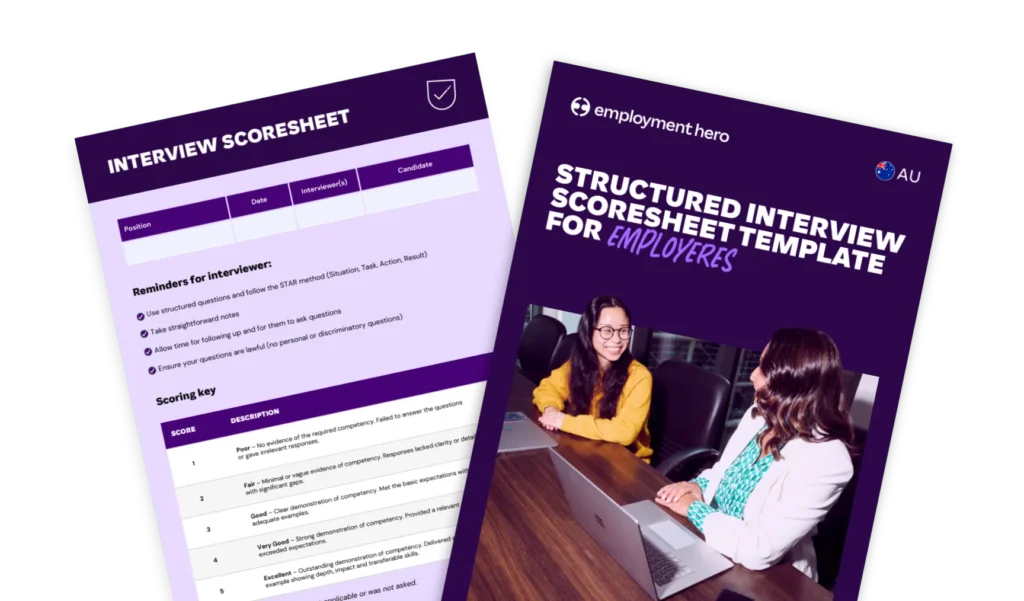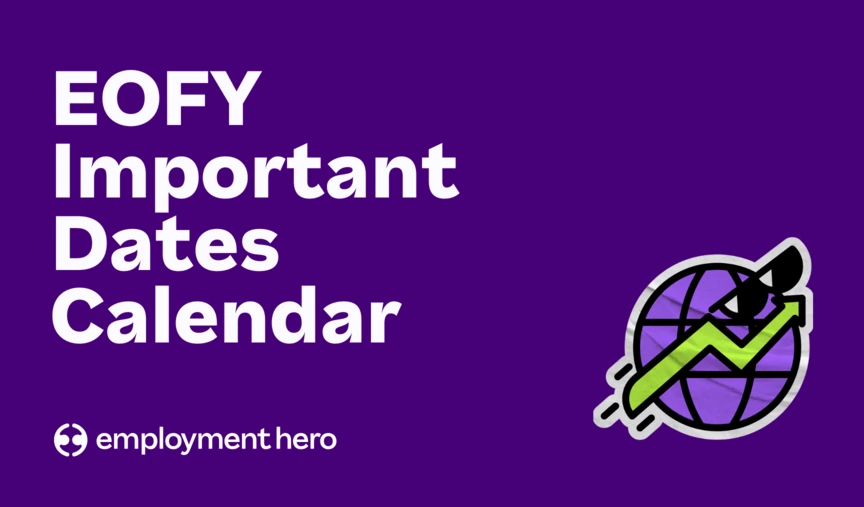Structured interview scoresheet template for employers
Published
Structured interview scoresheet template for employers

Finding and hiring the right people for your business is no easy feat. Between balancing the day-to-day and making confident hiring decisions, it’s all too simple for the job interview process to become inconsistent.
That’s where structured interview questions come in. By asking the same questions to every job candidate and scoring their answers against a set rubric, you can make fairer, faster and more confident decisions.
In our structured interview scoresheet template, we’ll share how you can build a structured interview process.
What is a structured interview and why does it matter?
A structured interview process is a type of recruitment technique. It involves every candidate following the same interview process, being asked the exact same predefined set of interview questions. This process allows hiring managers to assess their answers more objectively, as they’re rated against a consistent scoring system.
This approach differs from:
- Unstructured interviews: This is a casual interview with no set questions. This interview runs the risk of bias and inconsistency.
- Semi-structured interviews: This is a blend of some set questions, mixed in with some flexibility. It has less consistency than a fully structured approach.
Why should employers use structured interviews?
Using a structured interview process offers real advantages for hiring managers, including:
Consistent processes can make sure all of the boxes are ticked in the interview.
- Increased consistency as each candidate is assessed against the same criteria.
- Reduced chance of bias as standardised scoring makes decisions more objective.
- A clear interview framework is an efficient way to save time across the hiring process.

Key steps to build your own structured interview process
Building a structured, repeatable interview process doesn’t need to be complicated. Follow these steps and download our structured interview scoresheet template to get started.
Develop tailored questions
Craft structured interview questions aligned with these competencies. Use a mix of:
- Behavioural questions (e.g. Tell me about a time you solved a problem.)
- Situational questions (e.g. How would you handle a difficult customer?)
- Technical questions specific to the role you’re hiring for
You can find more in-depth interview questions in the template.
Establish a scoring rubric
Set a clear rating scale (for example, 1–5) with defined benchmarks. This makes sure all interviewers evaluate the candidates’ answers consistently.
Train interviewers
Train your hiring managers to follow the structure, avoid bias and apply the scoring rubric consistently in every interview context.

Sample structured interview questions to ask
Here are examples you can adapt for your own process:
- Introductory: “Why are you interested in this role?”
- Behavioural: “Tell me about a time you had to meet a tough deadline.”
- Situational: “How would you respond if a client wasn’t satisfied with your work?”
- Integrity: “What would you do if you noticed unethical behaviour at work?”
- Attention to detail: “How do you prioritise tasks when juggling multiple projects?”
Want to learn more about nailing your interview process? Download our interview guide for hiring managers.

How to score and compare candidate answers
When you fall into the trap of having unstructured interview questions, it can easily lead to inconsistent evaluations and unconscious bias. This is because the outcome is often based on gut feelings instead of the objective data at hand. The key to overcoming this is to use a structured interview process with a clear rating scale and evaluation metrics.
A structured approach makes sure every candidate is asked the same questions and is scored against the same rubric, helping to compare them fairly and consistently.
Our structured interview template provides a scoring key with a range from 1 to 5 to help you evaluate candidate answers objectively.
This rating scale helps you move away from subjective evaluations and toward data-driven decisions that lead to better hires. The scale in the template is defined as follows:
- 1 – Poor: The candidate did not demonstrate competency for the role.
- 2 – Fair: The candidate provided a limited or unclear demonstration.
- 3 – Good: The candidate met expectations.
- 4 – Very Good: The candidate provided an above-average response.
- 5 – Excellent: The candidate provided a strong response and clear examples.
This system helps you make confident hiring decisions by focusing on the skills and experience that truly matter for the role. By using a structured interview process, you empower hiring managers to own the process without getting bogged down in irrelevant information.

Making the process fair and compliant in Australia
In Australia, there are a few key pieces of legislation that govern employment, including the recruitment process. These laws exist to ensure fairness in employment and protections to people from any kind of discrimination.
With so much on the line, it’s essential all hiring managers are trained adequately on their legal obligations to ensure no discrimination occurs during the interview process.
The reality is that even one unintentional misstep from a hiring manager (like asking the wrong question in an interview) can lead to costly legal battles and reputational damage that can be difficult to recover from.
Here are the key pieces of employment legislation that hiring managers need to be across:
- Fair Work Act 2009
- Age Discrimination Act 2004
- Sex Discrimination Act 1984
- Disability Discrimination Act 1992
- Racial Discrimination Act 1975
- Equal Employment Opportunity (EEO) legislation
Learn all about recruitment compliance in our hiring compliance guide.
Enhancing the candidate experience
A great hiring process should leave job candidates with a positive impression of your business. Even if they’re not successful in securing the role, the way you run your interviews can strengthen your employer brand and make them more likely to apply for other roles in the future.
To create a great candidate experience, start by briefing candidates upfront so they know what to expect, including the structure, interview context and who they’ll be meeting and when. You want to keep the process transparent by explaining how their answers will be scored, what the process looks like and also when they can expect to hear back. During the interview, focus on creating a respectful, two-way conversation, instead of a one-sided assessment.
Finally, follow up with timely feedback, acknowledging their effort and sharing any constructive feedback. By making your structured interview questions fair, transparent and respectful, you’ll create a candidate experience that builds trust and makes top talent more likely to say yes to your employment offer.

Continuous improvement and refinement
To get the best results, regularly review your interview scoresheet and compare it with actual hiring outcomes. Check how effectively your interview questions and scoring system are predicting job performance and adjust where needed.
From here, you can see if certain scoring benchmarks need tweaking so they reflect the realities of the role. It’s also important to make sure interviewers are aligned and applying the scoring system consistently and without bias. By treating structured interviews as an evolving process, you’ll keep improving accuracy, fairness and long-term hiring success.
Download the structured interview scorecard template
Ready to put all of this into practice? Download our free structured interview scoresheet template to start conducting structured interviews. Happy hiring.
Disclaimer: The information in this template is current as at 1 October 2025, and has been prepared by Employment Hero Pty Ltd (ABN 11 160 047 709) and its related bodies corporate (Employment Hero). The views expressed in this template are general information only, are provided in good faith to assist employers and their employees, and should not be relied on as professional advice. The Information is based on data supplied by third parties. While such data is believed to be accurate, it has not been independently verified and no warranties are given that it is complete, accurate, up to date or fit for the purpose for which it is required. Employment Hero does not accept responsibility for any inaccuracy in such data and is not liable for any loss or damages arising either directly or indirectly as a result of reliance on, use of or inability to use any information provided in this template. You should undertake your own research and to seek professional advice before making any decisions or relying on the information in this template.
Register for the checklist
Related Resources
-
 Read more: EOFY Important Dates Calendar
Read more: EOFY Important Dates CalendarEOFY Important Dates Calendar
Gearing up for EOFY? To help you prepare, we’ve put together a calendar of important dates to support you through…

























